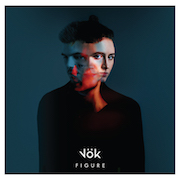As mainstream pop continues to shift and distort, turning its ravenous gaze towards the more obscure forms of dancefloor music – often with remarkable results that seduce teenyboppers and hardened, cynical “alternative” journos alike – the zeitgeist shifts that surround such movement still find ways to startle. I’m going to come clean and admit to being something of a dumbass, because when I first heard The xx’s debut album back in 2009, it didn’t to me sound like the work of a band that would soon sweep the airwaves, crop up in TV commercials or cross over, Mercury Prize in hand, to widespread success. To me the album sounded too introverted, ephemeral and spectral; but if Vök’s debut album Figure is anything to go by, the zeitgeist has well and truly shifted into inward-looking and moody territory, the likes of which we possibly haven’t seen since the new wave/goth heyday of the eighties or that brief period when shoegaze captured the imagination of more than few whimsical young people.
There are no two ways about it: Figure would not exist without The xx. It’s all in there: the muted take on bass-heavy dance music, the forlorn and romantic lyrics, the jangly guitar lines. A percussive line might be more beat-heavy here or there, but only to the same degree as The xx themselves have done on their recent I See You in an attempt to escape the straightjacket that was looming their way. The main difference, however, is that Vök have a solitary vocalist, Margrét Rán, and her airy soprano is, in fairness, very different to Romy Madley Croft’s. Rán’s delivery is pristine, her high-pitched vocals soaring from muted whimper to keening wail, sometimes in the same line. But what she gains in intensity she loses in intimacy and sensuality compared to Croft, apart from on the odd occasion when she sounds eerily close to a Cooly G or Roseau.
I suppose Rán’s vocals will suffice to ensure Vök’s fans (and, to their credit, the numbers are growing) that I’m full of shit and that the comparison doesn’t stand. In answer, I’d point to ‘BTO’, which follows the brooding dark ambient shuffle of opener ‘Breaking Bones’ with an insistent backbeat and lush bursts of synth bliss. It’s hook-laden and is sure to be a hit somewhere, but has The xx written all over it. That’s of course not a bad thing, in many ways ‘BTO’ is what ‘Dangerous’ might have sounded like without Jamie xx’s overbearing production flourishes – but it doesn’t break new ground. “When you’re going out of your way,” Rán moans, “do you think about us?” The romanticism is potent, but a little cloying, and the production, for all its timely swoops, handclaps and dreamy atmospherics, the production fundamentally lacks any of the unpredictability The xx often inject into their songs. Same goes for the futuristic, guitar-driven ‘Figure’, which sounds so much like the UK band I imagine some will assume it’s one of their outtakes until Rán’s admittedly awesome vocal kicks in and sweeps away that possibility.
Elsewhere, The xx influences dissipate somewhat as the album progresses, to be replaced with slower, less rhythmic textures. Vök cite Portishead and Massive Attack as influences, and that slowly becomes apparent on tracks like ‘Floating’, which carries a very portentous atmosphere. The problem is that a lot of the latter tracks on Figure are over quite quickly without making the kind of uneasy mark on the listener that the two Bristolian acts were so adept at. Margrét Rán certainly sounds at times vaguely like Beth Orton, but is often let down by a disappointingly slight production (‘Don’t Let Me Go’, ‘Show Me’). The album concludes with a trio of ambient pieces on which rhythm is stripped down to its bare bones and space is handed mostly to the vocals. By closer ‘Hiding’ this becomes a bit soporific and not even interjections on sax or piano really distract from the fact that the second half of the album feels a tad unfinished.
In many ways, Figure sounds like the work of a band that was inspired by The xx’s game-changing moment but too late realised that such change was ephemeral. The xx themselves are still wrestling with where to go next after their debut, so it’s hardly unexpected that other acts will find it a tough act to follow. On the more upbeat tunes, especially ‘BTO’ and ‘Figure’, Vök show a real ear for melody and Rán’s vocals are generally effective. But as they try to negotiate new avenues, the quartet loses focus and fails to land any original blows. I imagine there are a plethora of similar acts out there trying to guide the zeitgeist in ways that will pay off, but Figure shows that’s a lot harder than we might think.


